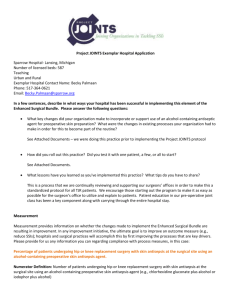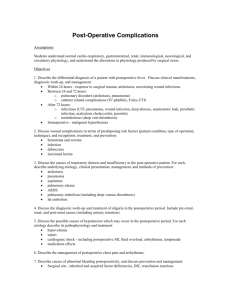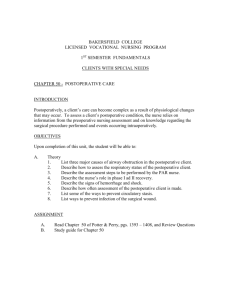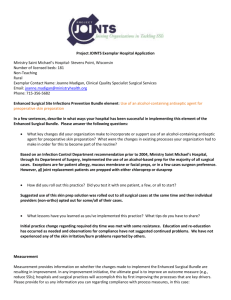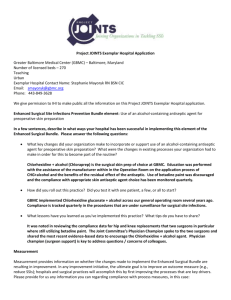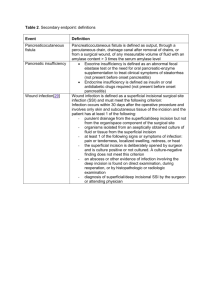1¾ « ñn í NORMAL
advertisement
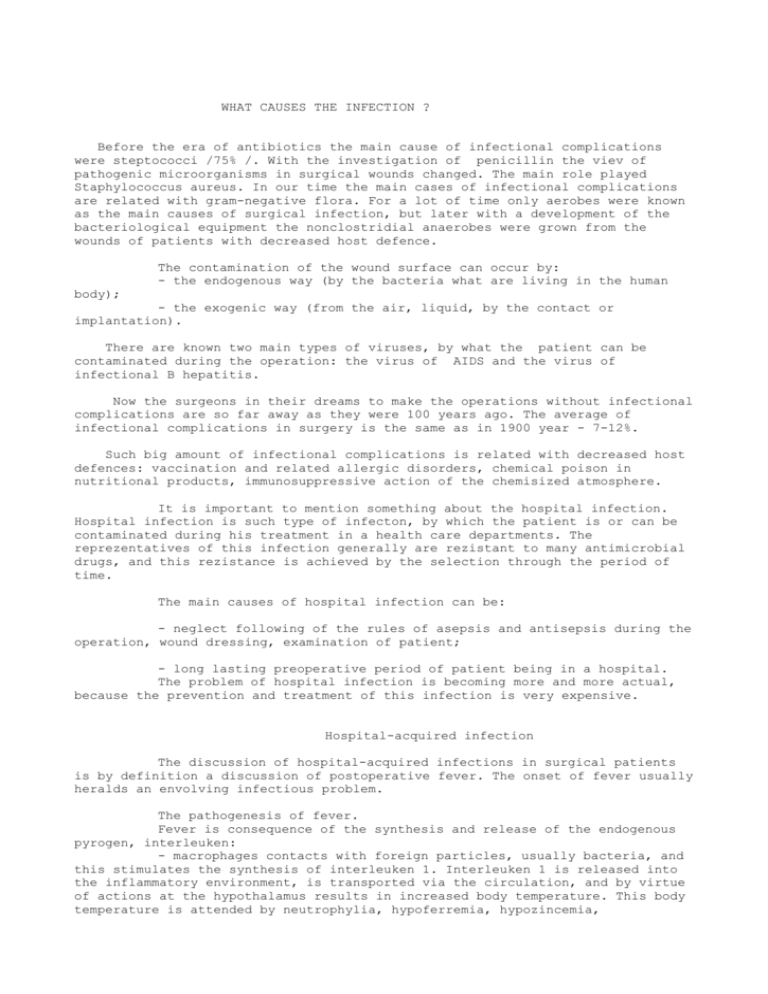
WHAT CAUSES THE INFECTION ? Before the era of antibiotics the main cause of infectional complications were steptococci /75% /. With the investigation of penicillin the viev of pathogenic microorganisms in surgical wounds changed. The main role played Staphylococcus aureus. In our time the main cases of infectional complications are related with gram-negative flora. For a lot of time only aerobes were known as the main causes of surgical infection, but later with a development of the bacteriological equipment the nonclostridial anaerobes were grown from the wounds of patients with decreased host defence. The contamination of the wound surface can occur by: - the endogenous way (by the bacteria what are living in the human body); - the exogenic way (from the air, liquid, by the contact or implantation). There are known two main types of viruses, by what the patient can be contaminated during the operation: the virus of AIDS and the virus of infectional B hepatitis. Now the surgeons in their dreams to make the operations without infectional complications are so far away as they were 100 years ago. The average of infectional complications in surgery is the same as in 1900 year - 7-12%. Such big amount of infectional complications is related with decreased host defences: vaccination and related allergic disorders, chemical poison in nutritional products, immunosuppressive action of the chemisized atmosphere. It is important to mention something about the hospital infection. Hospital infection is such type of infecton, by which the patient is or can be contaminated during his treatment in a health care departments. The reprezentatives of this infection generally are rezistant to many antimicrobial drugs, and this rezistance is achieved by the selection through the period of time. The main causes of hospital infection can be: - neglect following of the rules of asepsis and antisepsis during the operation, wound dressing, examination of patient; - long lasting preoperative period of patient being in a hospital. The problem of hospital infection is becoming more and more actual, because the prevention and treatment of this infection is very expensive. Hospital-acquired infection The discussion of hospital-acquired infections in surgical patients is by definition a discussion of postoperative fever. The onset of fever usually heralds an envolving infectious problem. The pathogenesis of fever. Fever is consequence of the synthesis and release of the endogenous pyrogen, interleuken: - macrophages contacts with foreign particles, usually bacteria, and this stimulates the synthesis of interleuken 1. Interleuken 1 is released into the inflammatory environment, is transported via the circulation, and by virtue of actions at the hypothalamus results in increased body temperature. This body temperature is attended by neutrophylia, hypoferremia, hypozincemia, hypercupremia, and the synthesis of acute-phase proteins by liver (C-reactive protein). All acute responses mediated by interleuken 1 arwe adaptive responses mediated by the the host to presumably bolster defenses against envolving infections. To manage fever in surgical patients, the source of pathogenmacrophage interaction must be identified. Empiric use of antibiotics should not be a customary practice; the primary focus must be identified and then disrupted by mechanical means (e.g. drainage of the infected areas). Postoperative fever. It's estimated that one-third of patients undergoing a major surgery will experience a postoperative fever. The evaluation of fever in this etting is based on a careful repeat history and physical examination along the selected laboratory studies. The workup entails the evaluation of the "four Ws" (wind, wound, water, walk). The lungs (wind) are most common culprit, especially in the early postoperative period, because atelectasis and/or pneumonia frequently follow general anesthesia and operative procedures. An auscultation and X-ray examination may improve the diagnosis. The operative incision (wound) should be examined by removal of all dressings and carefull palpation and inspection of wound edges. Any evidence of inflammation or drainage should be cultured and th skin sutures removed to facilitate drainage and debridement. The urinary tract (water) is evaluated routinely by a urinalysis and subsequent culture if pyuria is present. Extremity tenderness and swelling (walk) amd all intravenous catheter sites should be carefully inspected, as both thrombophlebitis and suppurative phlebitis can have very subtle causes of fever yet serious consequences. All intravenous lines or invasive monitor devices should be removed or changed and cultured. Empiric antibiotic coverage should be avoided if possible until the source of infection is identified. Occasionally drugs can cause a fever, but this should only be cosidered in the surgical patient after all other possibilities have been excluded. Pulmonary infection in the postoperative patient may be from three pathologically distinct causes: 1. First nonrespirator-associated pneumonia results from atelectasis. Poor postoperative tidal volumes resulting from anesthesia, analgesia, and painful abdominal or thoracic incisions provokes collapse of small airways. An optimal conditions for the development of microbes causes an interaction with macrophages (fever) within in the first 48 hours after surgical intervention. Prevention and management of atelectasis requires early ambulation, caughing, deep breathing, and even nasotracheal suctioning of postoperative patients. When a new fever and suspected atelectasis are present in the first 48 hours after surgery, laboratory examinations shows leucocytosis, and X-ray studies assures the presence of an infiltrate in the lung tissue - the systemic antibiotics should be administered according to the culture and sensitivity data. 2. Second, postoperative pneumonitis may be respirator associated. Critically ill patients are very vulnerable to infection while on the ventillation. The lungs has usually been assalted by large volumes of intravenously administered fluids. The endotracheal tube represents a foreign body that injuries tracheal mucosa and permits bacterial proliferation. The ventillator then serves as a reservoir to "shower" the vulnerable pulmonary tissues with multiresistant hospital microflora. Weaning the patient from the ventillator promptly is the most important preventive measure. Because the opportunistic gram-negative species (Pseudomonas, Serratia) are dominating - an aminoglicosides and later generation penicillin (ticarcillin, pipercillin) should be administered. 3. Third aspiration is an ever present risk in the postoperative patient. The patient at risk for aspiration will ususally have gastric distension and altered mental status. Head-injured and eldery patients are particularly at a risk. Prevention is based on the gastric decompression, intensive care of patient in early postoperative period, position of patient just after surgery with head turned to the side and bend lower than the whole body position. Treatment. Once aspiration has occured, bronchoscopy will be diagnostic and may also permit evacuation of aggressive acid secretion from the tracheobronchial tree. If hypoxemia is present after aspiration, management must be supported by systemic oxygenation. Antibiotics should be withheld until clinical and culture evidence identifies an organism for specific therapy. The usage of massive doses of corticosteroids in a case of aspiration is contraversal. Urinary tract infection postoperatively usually is related with the use of Foley catheter. These catheters traumatize the bladder and urethral tissues and provide ready access for pathogens. To-and-fro movements of the catheter provide a "sump" effect to transolate catheter and urethral microorganisms into the bladder. The diagnosis of postoperative urinary tract infection has traditionally been the quantitive bacterial culture. When more than 100.000 organisms/ml of urine are identified, an acute infectious-inflammatory process in this tract can be suspected. In a presence of the catheter not usual urinary tract pathogens (E.coli) must be suspected, but poliresistant species (Pseudomonas, Serratia, Candida, enterococci) should be examined. Prevention requires aseptic placement of the catheter, firm fixation of the catheter after placement, maintaince of the closed drainage system, daily catheter care, and removal of the catheter when its specific purpose has been served. Systemic antibiotics will not prevent postoperative urinary tract infection but only modify the microflora that are potential pathogens. Treatment. In an absence of functional or anatomical obstruction, the main management consists of the removal of the catheter and an adequate "flush" by a volume-induced duresis. Antibacterial treatment is organized according to the culture sensitivity tests. Wound infections. Postoperative fever should sensitize the clinician to look where "the hands of man" have been. The wound is allways a prime suspect, especially when the tenderness, redness, heat or a mass effect are noted when inspecting the wound. The discharge of pus from the wound is definitive. The absence of "healing ridge" in the portion of the incision is also a useful clinical sign of wound infection. Treatment. A wound infection requires the wound to be opened. Pus is evaquated, fibrin is debrided, and subcutaneous suture material should be removed. Systemic antibiotics are not an alternative to drainage. Antibiotics are only necessary for the patients with severe or progressive cellulitis, and for those patients with necrotizing infection. Intraabdominal infection postoperatively occurs in two settings. 1. Complications of elective gastrointestinal or billary tract surgery may result in postoperative peritonitis or abscess. The majority of postoperative intraabdominal infectious complications are abscesses. Major dehiscence of the anastomoses is usually associated with florid sepsis, and reoperation for management of this complication is usually based on clinical criteria. Abdominal tenderness and pain, fever, leukocytosis, and the toxic septic state rather than the roentgwenograms, contrast studies, or other sophisticated diagnostic diagnostic methods are the most important indicators of need for reoperation. Patients who have had an initial laparotomy for infection or penetrating trauma will commonly have a degree of bacterial contamination that makes a subsequent abdominal abscess a frequent event. The diagnosis of intraabdominal abscesses is quite difficult. Localized tenderness is only useful in about one-third of patients, and palpable masses are of benefit in less than 10% of patients with abscesses. The rectal examination continues to be particullary valuable method when pelvic abscess is a concern. X-ray examination of the abdomen are helpful when positive findings are identified but are unfortunately not common present. The so called"three way" abdominal series (an upright chest film, upright abdominal film, and lateral decubitus film) is frequently ordered, but useful in less than 20% of patients. Upper or lower gastrointestinal graphic studies may show filling defects or intestinal leaks. Ultrasound has been a poppular diagnostic method used in identification of intraabdominal abscess. However the receiver surface must make direct contact with the skin of the abdomen. In patients with dressings, open wounds, stomas the ultrasound may not give a complete examination. Galium-67 scans have generated considerable interest as a diagnostic tool for the patient with suspected abscess. Galium localizes in all areas of inflammation, which includes the surgical wound. With accuracy better than 90%, computed tomography (CT) is the fastest and most useful diagnostic study for suspected intraabdominal abscess. Treatment. Drainage is the primary treatment of an intraabdominal abscess. Drainage allows removal of the bacteria, fibrin, and debris that are fueling the septic process. The drainage must be done through the shortest way outside. Often the CT or other radiologically guided percutaneous methods are usefull. Infection of the abdominal cavity is usually polimicrobial (E.coli in associations with nonclostridial anaerobes are often found). Usually an aminoglycosides with metronidasole or clindamycin are used to cover the main species of pathogens. Pleural empyema may be a complication in the postoperative period after thoracotomy or chest tube placement. It may occur occasionally spontaneously or in association with a pneumonic process. Endogenous flora from pulmonary or esophageal resection or from technical failures of these resections may cause empyema. Chest drainage tubes represent "two way streets" that may allow blood and fluid to exit the pleural space, but may also permit exogenous bacteria into the pleural space. Diagnosis is based on X-ray examination, CT or ultrasound scaning. Because the patients are lying down most of the time, a loculated empyema cavity may be very posterior. It's important to distiguish between loculated empyema, lung abscess, and combinations thereof. The diagnosis may be confirmed by aspiration of pus by needle thoracocenthesis. Treatment. The pathogens of empyema are higly variable, and gram stain of pus is quite useful in antibiotic selection. An antibacterial drugs should be used in generally and locally for the irrigations. Antibiotic failure in patients with appropriate coverage usually reflects inadequate drainage. In the latter stages rib resection to marsupialize the empyema may be necessary. Intravascular device-associated bacteremia. Surgical patients inundated with invasive intravascular catheters and devices. peripherial intravenous cannulae, Swan-ganz catheters, percutaneous pacemakers, and arterial lines are often used in patients within the intensive care unit. These portals of entry into the intravascular compartment are being recognized with increasing frequency as sources of postoperative nosocomial bacteremia. An intimal injury with localized clot formation may serve as an aditional growth media for bacteria, what enters into the vessels from the skin. Likewise, contamination of this clot may allow suppurative thrombophlebitis to evolve with the persistent bacteremia after the catheter has been removed. The diagnosis of intravascular device bacteremia is suspected in any postoperative surgical patient with positive blood cultures, particullary when either Staphylococcus aureus or Staphylococcus epidermidis are recovered. Treatment of intravascular device-associated bacteremia is the removal of the foreign body. The patient's clinical response to removal will usually confirm the diagnosis. Persistent fever, leukocytosis, and bacteremia suggest suppurative thrombophlebitis - local incision and drainage may be necessary to identify pus within the vein. Antibiotics specific to the bacteremic organisms are used until clinical resolution occurs. Therefore many clinicians continue parenteral antibiotics for 10-14 days in patient with staphylococcal bacteremia. Prevention of this complication requires that peripheral intravenous cannulae,Swan-Ganz catheters, arterial lines,etc., not to be left in place more than 72 hours. Only the hyperalimentation catheters should be maintained for a longer period, and they must be handled with meticulous sterile technique. ASEPSIS - ANTISEPSIS ASEPSIS Aspects of history of asepsis: The beginning was in a killing of microorganisms from the surface of wound antisepsis, but later in 1880 it was decided to prevent the contamination of wound surface by the microorganisms - asepsis. The antisepsis was changed in to asepsis. After the investigations of Lister everybody saw that carbolic acid is not the drug of choice, because, principally, this chemical substance is organothropic poison and have a lot of side effects. In 1878, Buchner successfully used boiling of surgical instruments. In 1881 Koch and Lephler for the decontamination of surgical instruments used flowing steam of boiling water. In 1882, in Bon the first autoclave was created. In 1890 the first sterile rubber gloves were used by Halsted. With that a new era of asepsis started, and everybody forgot the antisepsis. But life showed, that only interaction of asepsis and antisepsis can be successful in the prevention of putridial complications. Definition Surgical Asepsis means the prevention of the access of microorganisms in an operative wound. This can be achieved by the methods designed to destroy bacteria or remove them from all objects coming in contact with the wound. various physical, chemical and biological methods of asepsis can be used. Modern surgery is aseptic not only in the use of sterile instruments, sutures, dressings and wearing of operating personal sterile gowns, rubber gloves, but also providing operations and treatment of patients in a special germ-free isolators and sterile environment. Sterilization Sterilization is the process of killing all microorganisms / bacteria, spores, viruses, mycotic agents and parasites /. It is ultimate to disinfection, but disinfection kills only vegetating microorganisms, not spores. The practical criterion of sterility is the failure of microbial growth in bacteriological tests. Sterilization can be achieved by either physical or chemical agents: - steam under pressure. Application in steam under pressure of 15 psi / pounds per square inch / for 15 to 45 min will destroy all forms of life. Steam of boiling water under pressure raises the temperature to 121*C. Autoclave. This method is most popular because of its high power of penetration microbiological efficiency, ease to control and economy of operation. Usually there is used 121*C of temperature and 2 atm of pressure for 45 min. - high-vacuum sterilization. A vacuum pump makes a vacuum in the chamber, what raises the efficiency of penetration, and only 3 min are needed to achieve sterility rather than in the 20 min in a regular system. - dry-heat sterilization is commonly used for glassware, for the sterilization of talc, vaseline, fats and oils. That method means baking of material at 170*C /340* F/ for 1 hour. - gas sterilization is used by the ethylene oxide. The killing action is slow, and an exposure period is needed from 3 to 6 hours. This method is used for delicate sterilization of surgical instruments with optical lenses, for tubing and plastic parts of heart-lung mashines, respirators. Ethylene oxide is most reliable when applied to clean, dry surfaces that do not absorb the chemical. - radiation sterilization refers to ionizing radiation by cobalt 60 sources /gama radiation/ and by electron accelerators /high energy electrons/.It is used for various heat-sensitive material, such as sutures, plastics... - chemical sterilization is currently achieved with a 2% aqueous solution of glutaraldehyde. This compound is an effective disinfectant for surgical, anesthetic and dental equipment, what is heatsensitive. Isopropyl alcohol may also be used for the chemical sterilization, but only in the absence of spores sterilization can be effective. ANTISEPSIS Aspects of history of antisepsis: Since the middle of XIX century the main what stopped the development of surgery was the putridial complications of surgical wounds. These complications about 80% caused sepsis and death of a patient. Ancient Egyptians thought that it is useful to wash the wounds with a water from silver plates. Ancient Grecians washed the wounds with a rain water and wine. In 1847 Semmelveis in a Hungarian clinic of obstetrics successfully used chloride of lime in a hand preparation. This helped to decrease the complications from 18% to 1,2%. In France, in 1864 Pasteur announced the results of his scientific work, that the cause of infection are small, alive subjects, able to multiple. In 1867 in England D. Lister used 3-5% carbolic acid as antiseptic to disinfect contaminated wounds and he became the creator of antisepsis. All these investments were achieved and their action verified in a surgical practice during various wars. Definition An antiseptic is a chemical agent that either kills pathogenic microorganisms or inhibits their growth so long as there is contact between agent and microorganism. The term "antiseptic" is reserved for agents applied to the body. The antiseptic may actually be a disinfectant used in dilute solutions to avoid damage to tissues. A disinfectant is a germicidal, chemical substance used on inanimate objects to kill pathogenic microorganisms but not necessarily all others, especially the spores of microorganisms. These agents are usually used to disinfect floors, fabrics and exreta in hospitals. Antisepsis means to kill microorganisms, asepsis means the prevention of the absence of microorganisms. Hoverer, the first step in any process of biological decontamination is through mechanical cleansing with soap or detergent and water to remove all traces of blood, pus, proteins, and mucus before the antiseptic or disinfectant is used. Types of antisepsis: - chemical antisepsis - when there are used various chemical substances with a bactericidal or bacteriostatic activity; - physical antisepsis - when there are developed conditions suppressing bacterial activity: cold, heat, wound dressings, drainage tubes, physiotherapy. - biological antisepsis - all methods that helps to raise the imunic activity of the organism and helps to maintain the physiology of the wound: antibiotics, bacteriophags, serums, vaccines, immobization, rest of the patient; - mechanical antisepsis - all mechanical meams directed to eliminate the necrotic tissue, foreign bodies, to drain the secretion of the wound; - prophylactic antisepsis - methods to avoid the development of special selective and dangerous bacteria - such as tetanus and other; The methods of antisepsis: - superficial antisepsis - when wound dressings are flourished with antiseptics, antiseptic baths, irrigation of wound with antiseptics; when the - deep antisepsis - when antiseptics are inserted into the tissue, pathologic cavities are washed with antiseptics; - haematogenic antisepsis - when antiseptics are used intravenously or in to the arteries; - local antisepsis; - general antisepsis, - mixed antisepsis. TOPICAL AGENTS Agents that can kill or inhibits the growth of microorganisms when applied to living tissues without significant harm to the tissues. Antiseptics are widely used but their efficacy and hazards are poorly understood. PHENOLS: Phenol /carbolic acid/ was first used in 1867 by Lister. A 1 to 2% solution is effective against all nonsporulating bacteria and fungi, but clinical usefulness is limited due to systemic toxicity manifested by CNS stimulation with muscle tremors. HEXYLRESORCINOL in a 1:1000 concentration allows effective penetration and spreading, but may cause skin irritation. ALCOHOLS: Ethyl alcohol /50 to 70% solution by weight/ and isopropyl alcohol /70 to 90% solution by weight/ are both effective germicidal agents, but isopropyl alcohol has the advantages of lower volatility, higher germicidal activity and less potential for tissue corrosion. HALOGENS: Iodine is one of the oldest and most potent antiseptics. In a 1:20000 solution it is bactericidal after 1 min. and sporocidal after 15 min. There are some disadvantages using iodine preparations: skin staining, tissue irritation, hypersensitivity reactions, pain. IODOPHORS: are complexes of iodine usually with a surface active agent. Iodophores such as povidone-iodine are less effective than the aqueous and alcoholic iodine solutions, but may be less irritating and less toxic. ACIDS: Boric acid is weekly germicidal and nonirritating. But it is readily absorbed if applied to large denuded areas, and can cause severe systemic toxicity with gastrointestinal disorders, hypothermia, renal impairment, vascular collapse, shock and death. It can be limitedly used only in ophthalmology. OXIDIZING AGENTS: Hydrogen peroxide as 3% aqueous solution is weakly germicidal and very unstable, but very useful for cleansing wounds. The antibacterial and high mechanical activity is due to the rapid release of O.3% solution provides disinfection, 6% solution provides sterilization. Kalii hypermangananatis is effective oxidizing and odorating agent. 0,01- 0,05% provides disinfection, 2% provides burns. ALDEHYDES: Formaldehyde in a dilution of 1:200 is bactericidal after 6 to 12 h but the solution is too irritating for clinical use. Methenamine can be used as urinary antiseptic, but it should not be used in patients with hepatic insufficiency. HEAVY METALS: Mercury compounds exert antibacterial action by reversible binding to sulfhidryl enzymes in microorganisms. However, they are highly toxic to tissues, and penetrate poorly. Mercuric oxide ointment 1%, amoniated mercury ointment, thimerosal, nitromersol and merbromin. Silver nitrate solution in a 1:1000 dilution rapidly destroys most microorganisms. As a 0,5% solution it has been used extensively in the treatment of burns to prevent infection. Prolonged use may cause an argyria, methemoglobinemia. 1% silver nitrate ophtalmic solution is commonly used as prophylaxis for gonorrheal ophthalmia neonatorum. SURFACE ACTIVE AGENTS:Antiseptic surfactants include both anionic and cationic compounds. Most anionic surfactants are effective against gram-positive bacteria. The cationic surfactants are effective against gram-positive and gramnegative bacteria, as well as some fungi and viruses. The advantages: rapid action, good tissue penetration and low systemic toxicity. The disadvantages: fast inactivation by soaps and the formation of film on the skin under which some bacteria may survive. FURANS: Nitrofurazone is bactericidal against many gram-negative and positive microorganisms in dilutions up to 1:75000. It is clinically useful as topical antiseptic on surgical wounds and superficial skin lesions including burns, ulcers, but systemic toxicity may result from absorption from large wound areas. 1:5000 furacilline kills only gram-positive bacteria. MISCELANEOUS AGENTS: Mafedine acetate is a useful topical sulfonamidelike agent, available as an 8,5 to 10% cream for applying to burns to prevent bacterial invasion. It provides effective prophylaxis against both gram-positive and negative bacteria, especially Pseudomonas aeruginosa. A disadvantage is severe pain on application or removal. Silver sulfadiazine is a topical antiseptic, effective against many bacteria and fungi,but some microorganisms are resistant to its bacteriostatic effect. It has been clinically useful for the treatment of burns, where it has the advantages of prevention of Pseudomonas infections. PAINTS: Brilliant green 1-2% concentration ethyl alcohol solution. Methylen blue 1-3% concentration ethyl-alcohol solution. This antiseptic material is useful to contrast the pathological cavities of human body, mostly these materials are effective against strepto - staphyllo group of bacteria and their effectiveness is reduced in the presence of pus or serum.
